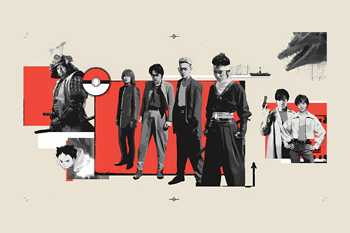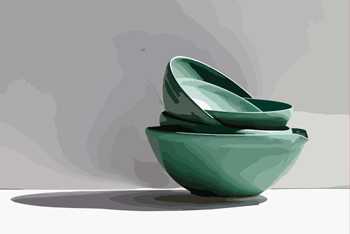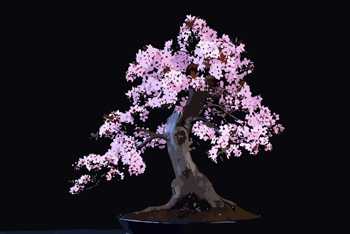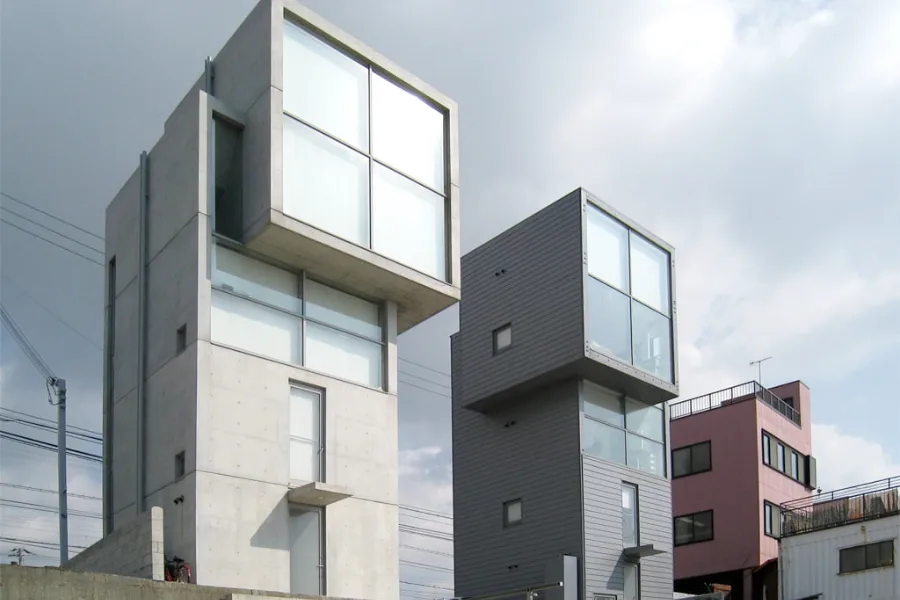Japanese architects can be collectively categorized as having eccentric taste and the utmost creative and personal expression. This freedom to create pushes the boundaries of architecture and aesthetics, allowing for the establishment of functional structures that look more like artwork than traditional brick-and-mortar infrastructure.
Check out our favorite Japanese architects below for an introduction to their designs, philosophy, and architectural design in Japan.
Tadao Ando: Japan’s Self-Taught Master Architect

Tadao Ando is an acclaimed Japanese architect with an astonishing story. One can’t help but feel awed by his contemporary architecture, which merges brutalist and spatial elements to create distinctly interesting and photogenic structures. His designs typically use shapes that harmonize with the landscape, using space and light to create complex imagery while retaining a minimalist silhouette.
But unlike many acclaimed architects, Tadao Ando was purely self-taught, having only been a professional boxer and truck driver prior to his deep dive into the world of modernist architecture. With his well-known determination and tenacity, he blazed through four years of architectural readings within 12 months and opened Architect & Associates in Osaka in 1969. He then went against convention by operating in Tokyo to seek success.
With 200 buildings and counting to his name, Tadao Ando is one of Japan’s most celebrated architects. He won the prestigious Pritzker Prize in 1995, the architecture world’s most distinguished award. He honorably donated the prize money of 100,000 USD to victims of the 1995 Kobe Earthquake.

Known For
Tadao Ando is known as the king of concrete, as his works primarily use concrete to form interesting shapes, which are paired with subtle lighting to guide the mood of the interior. He is also a master of utilizing space to simulate a unique atmosphere that encourages visitors to reflect from within. This Japanese building style has gained global popularity amid the heightened interest in minimalist and brutalist architecture. But don’t let that stone-cold moniker fool you. Ando has always stressed the importance of creating architecture as a home for people’s hearts.
“…If you give people nothingness, they can ponder what can be achieved from that nothingness”

Design Philosophy
Tadao Ando was influenced by mid-century European architects, such as Frank Lloyd Wright, Louis Kahn, and, profoundly, by the Swiss-French architect Le Corbusier. Le Corbusier was known for building structures out of reinforced concrete and revolutionizing urban planning.

Notable Work
Kazuyo Sejima: Spatial Harmonizer
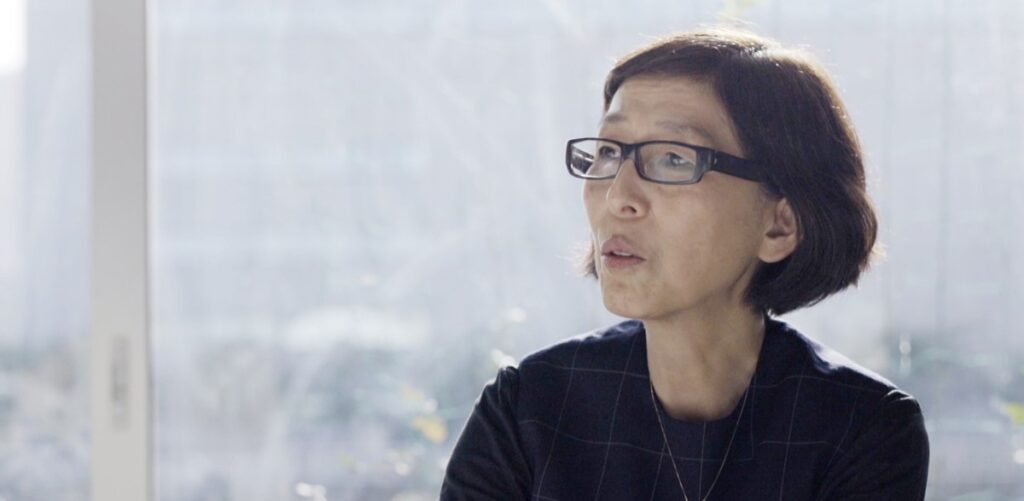
One of the most famous Japanese architects is Kozuyo Sejima, a former apprentice of the renowned Toyo Ito. She rose to prominence in the mid-90s after partnering up with Ryue Nishizawa to form SANAA (Sejima and Nishizawa and Associates). Together, they won the illustrious architectural Pritzker Prize in 2021. Sejima was also the first woman to be appointed as director of the architecture sector of the Venice Biennale for the 12th Annual International Architecture Exhibition.

Known For
Kazuyo Sejima’s works primarily focus on communal spaces and contemporary museums, creating an impactful visual that doesn’t disrupt the environment. This is achieved by using playful forms, like clear glass in curved structures, which invite inhabitants to look outside while also reflecting their own image.
Sejima truly believes in blending a building’s outdoor space with the interior. Each of her buildings stands out and becomes the highlight of the architectural design in Japan, yet it doesn’t sacrifice function from within. Sejima designs each of her buildings, from women’s dormitories to museums and communal spaces, as livable art, where both beauty and function are central to the architectural process.
“I have a dream that architecture can bring something to contemporary society. Architecture is how people meet in space.”
Sejima’s buildings are known for their smooth-surfaced modernist style of assimilated glass and marble. Sejima, however, does not consider her designs finished until the occupants have breathed life into them by settling in.

Design Philosophy
Kazuyo Sejima has been known to challenge the traditional conventions of the design process. At the core of her craft is the experience of the occupant and their relationship with the surroundings. As stated on most occasions that Sejima takes inspiration from the building’s site and its surroundings before starting any project. She designs her buildings to integrate and bring people together through open spaces that connect the interior and exterior.
“In the past, I would try to understand the overall character of a building’s environment and use this abstract idea to develop a design. Today, I try to create spaces that are more precisely adapted to the variable character of a neighborhood.”

Notable Work

Further Reading

World-renowned Japanese architect Kengo Kuma and his firm “Spatial Design Studio” have completed 300 architectural projects. He is an alumnus of Columbia University, the University of Illinois, and Keio University.
Kengo Kuma designs buildings with an emphasis on nature and natural light, believing that the combination creates a connection between the physical and non-physical comfort of inhabitants. He does this through visual continuity between his structures and the environment, intentionally placing them in a form that doesn’t disrupt the surroundings.
“My buildings are always part of the place, part of the location. I want to merge buildings into the environment as best I can. Harmony is always the goal of my practice”

Known For
Kengo Kuma is known for his use of wood, which was also traditionally used in old Japanese buildings. In fact, Kuma used wood to construct the 2021 Olympic Stadium in Tokyo, something he refers to as a ‘living tree’.
In addition to wood, Kuma favors working with “alternative” locally sourced materials such as bamboo, stone, vinyl, and ceramics. His projects are deeply rooted in traditional architectural design in Japan, insisting on the spiritual rather than the physical.
Fundamental to Kuma’s body of work is the use of light, evident in his design called Marseilles (2012), which features distinctive facades covered with semi-transparent glass panels.
Sunny Hills Minami-Aoyama
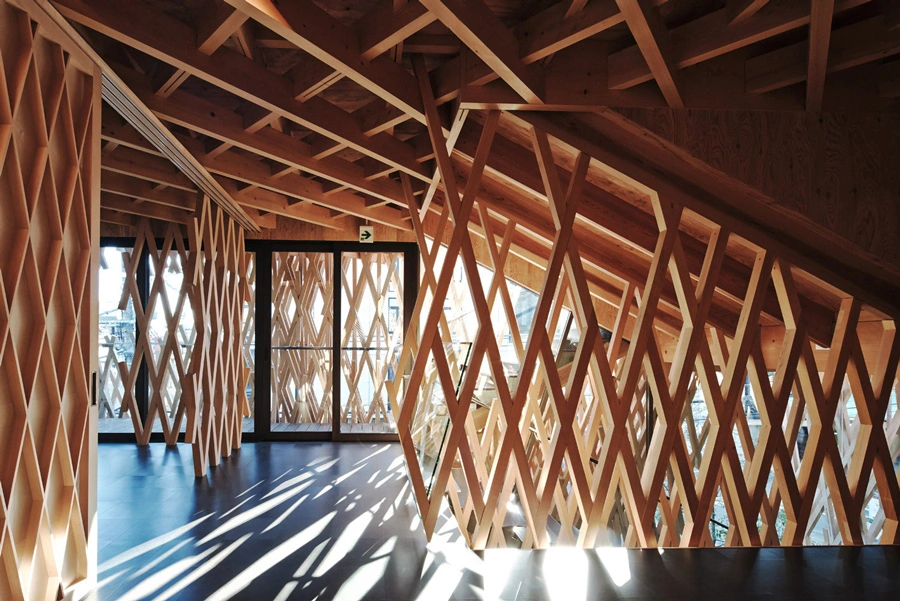
Design Philosophy
Kuma has an inseparable connection between the ‘emotional content’ of the materials he utilizes and the qualities of his construction projects. Kuma sees his design style as in direct opposition to ‘Western architecture,’ which he considers to be characterized by “excessive objectification” that inhibits healthy contact with the outer environment. He believes that nature must be framed with nature, and this is evident in his sensible use of form and material in structuring buildings that are in tune with the natural world.
Kuma continues to reimagine traditional Japanese architecture and architectural elements from the 21st century. He manipulates traditional elements into statement-making buildings while retaining the core of his design philosophy: to ‘produce a thing from a place’ through the use of form and materials in architectural design in Japan.

Notable Work

Further Reading
Itsuko Hasegawa: The Utopian Urbanist

Winner of the inaugural Royal Academy Architecture Prize and an honorary fellow of the Royal Institute of British Architects, Itsuko Hasegawa has designed a number of award-winning buildings in Japan and abroad through her firm, Itsuko Hasegawa Atelier.
Known For
A fundamental principle of Itsuko Hasegawa’s architecture is communication. She formed her roots by communicating with local communities and understanding their needs, which propelled her to create designs that benefit the public. She also designs buildings to enable people to interact within functional spaces.
Hasegawa views this relationship as a positively reinforcing feedback loop. Over the years, Hasegawa has designed many residential and public buildings that are considered ‘social buildings,’ from cultural centers to museums and centers for performing arts.
“My interest is in making a place where different people can come together and can enjoy a range of activities. I see the role of the architect as creating a place where this kind of inclusiveness can occur.”
Sumida Culture Factory

Design Philosophy
Itsuko Hasegawa’s experimental architectural form has its roots in post-war Japanese architecture known as the Metabolic Movement, which was built upon the foundation of cultural resilience. Metabolic architecture blends brick-and-mortar megastructures with organic, biological influences. It emerged as a response to Japan’s rapid growth during the economic bubble, when buildings couldn’t keep up with the fast-changing society. These structures are designed to evolve over time, with the ability to be modified and grow.
In keeping with the tenets of this unique form of architectural design in Japan, Hasegawa approaches her work as a combination of architecture and urban design. Her buildings serve to act as a dialogue with the community, with the inclusiveness of the people being a priority.
“I start by thinking of those people rather than of the brief that’s been written by the politicians or whoever is sponsoring the competition. Even though architecture is fundamentally a public entity, often the needs of the public are not well represented.”

Notable Work

Further Reading
Shigeru Ban: The People’s Architect

Another recipient of the Pritzker Architecture Prize, Shigeru Ban is a Japanese architect who pioneers a change in priorities of today’s architects. By most accounts, Shigeru Ban is humanitarian in his pursuit of architecture.
Ban’s resourcefulness and affinity for unorthodox building materials have resulted in the creation of some of the most human-focused Japanese structures, from refugee shelters to earthquake-resistant churches. He has extensive knowledge of the use of paper and recycled materials, which he applies in the building of temporary housing and social infrastructure (such as schools and churches) after natural disasters across Japan and other parts of the world. These are easy to build and disassemble and are cost-efficient enough to serve local communities across impoverished parts of the world.

Known For
Shigeru Ban’s innovative work with paper and cardboard tubes has produced structurally sound buildings all over the world, allowing Japanese architecture to leave a mark in the humanitarian sphere. Ban first used paper tubes in the 1980s, in a gallery for famous Japanese fashion designer Issey Miyake.
It was in the mid-80s that Ban realized that paper and paper-based materials could be used effectively to build weight-bearing structures, enabling Ban to develop his own brand of architecture.

Design Philosophy
Shigeru Ban’s primary philosophy is that an architect must come up with distinct concepts to create their projects to be free of fleeting trends and external influence. His work is built on compassion and kindness, as well as a solution-oriented approach to architecture that responds to inescapable disasters and challenges posed by climate change.
“An architect does not need to spend his whole career making monuments for rich people.”

Notable Work

Further Reading

Kumiko Inui is a graduate of the ‘class of 92’ at the Tokyo National University of Fine Arts and Music. She is best known for her use of optical illusions and trademark facades, and her philosophy of creating ‘little spaces’—communal spaces for collective gathering.
Inui is an acclaimed contemporary artist whose work has been featured in exhibitions at the Berkeley Art Museum and Pacific Film Archive. Her architectural design in Japan has been commended nationally and internationally. In 2012, she, together with Japanese architect Toyo Ito, received the Golden Lion for the Best Pavilion at the 13th Venice Architecture Biennale.

Known For
Kumiko Inui made her name making eye-catching silhouettes for luxury brand boutiques, a skill she developed whilst working under the tutelage of Jun Aoki, a famous Japanese architect who specializes in high-end retail designs. The optical illusions in some of her buildings elicit awe from visitors and residents, with architectural design in Japan that appear to be solid structures from afar yet dematerialize when approached.

Design Philosophy
Inui enjoys her creative process tremendously. Moreover drawing intuitively and almost automatically, she creates a repetitive pattern of the same drawing, which she refers to as ‘unconscious creation.’ Kumiko Inui’s sketches reveal the individuality of her designs. She describes her sketching method as ‘drawing without thinking,’ an impromptu method for developing abstract notions. Inui would constantly go back to her first sketches, reinterpret them, and come up with a new concept.
This meticulous thought process is the basis for her ability to express a story within her architecture, which is always designed like public artwork. Unlike her predecessors, who created old Japanese buildings with function at the forefront of their priorities, Inui brings a touch of high-fashion-inspired architectural design in Japan into the mundane, while retaining her philosophy of incorporating ‘little spaces’ where possible. This is especially visible in the waiting area at Shin-Yatsushiro, which looks more akin to an art installation.

Notable Work
Apartment I (2007; recipient of Shin-Kenchiku Prize),
TASAKI Ginza Main Store

Further Reading
Sou Fujimoto: The Primitive Futurist

Kumiko Inui is a graduate of the ‘class of 92’ at the Tokyo National University of Fine Arts and Music. She is famous for using optical illusions and trademark facades, as well as for her philosophy of creating ‘little spaces’—communal areas for collective gathering.
Inui is an acclaimed contemporary artist whose work has been featured in exhibitions at the Berkeley Art Museum and Pacific Film Archive. Her architectural design receives prasie both nationally and internationally. In 2012, she, together with Japanese architect Toyo Ito, received the Golden Lion for the Best Pavilion at the 13th Venice Architecture Biennale.

Known For
Sou Fujimoto is also regarded as a conceptual artist as he seeks to combine new forms. He deconstructs his art, drawing heavy influence from nature and landscapes. Rather than just focusing on public spaces, Fujimoto also designs residential architecture, creating adaptable, livable art. It is precisely due to Fujimoto’s conscience for the environment that his architectural style feels more diverse and varied compared to other famous Japanese architects.
Interior and outdoor, residential space and street, constructed environment and nature are all blurred in Fujimoto’s art. Therefore they are all harmonized to evoke a feeling of extending the external environment to the internal, and vice versa. Sou Fujimoto’s bold, innovative approach to architectural design in Japan focuses on striking a balance between privacy and visibility for residents.

Design Philosophy
Fujimoto views the marriage of architecture and nature to be essential, thinking that only by achieving complete integration of the two can superior design be created. Nature and architecture connect intimately, creating one-of-a-kind buildings that embrace the surrounding world. His style, focused on adapting to the natural environment, enables him to diversify his architectural designs, free from limitations of specific materials, shapes, patterns, or optics. As a result, every one of Fujimoto’s works feels fresh and truly caters to unique surroundings.
Fujimoto thinks that by combining the two components, they must be treated in the same way. Plant life, like the architecture that supports and integrates with it, requires daily maintenance, a design concept that he dubs ‘primitive future.’
“…I believe that architecture should be linked to people’s lives, so everyday life and everyday care for nature as well as for the building itself should be in harmony…I believe that if people love their environment they take better care of it…”

Notable Work
L’Arbre Blanc, Montpellier, France, 2017
Serpentine Gallery Pavilion, London, 2013
The Cloud pavilion in Tirana, Albania
House of Budapest (2021)

Further Reading
We attended Japan House London’s very first exhibition that showcased Sou Fujimoto’s ‘Futures of the Future’.
Sou Fujimoto (ARCHITECTURE GENERALE) – a comprehensive examination of Fujimoto’s dynamic work.
Toyo Ito: The Merging Naturalist

Toyo Ito is one of the most influential Japanese architects whose architectural design in Japan are known for projecting an air of optimism and joy. He started as an architect for a practitioner of the Japanese Metabolic Movement, Kikutake Kiyonori, but eventually left to start his own practice after the decline of this architectural style. Since going independent, Ito has earned numerous prestigious awards, such as the Pritzker Prize and the Golden Lion for lifetime achievement at the 2002 Venice Biennale.
Toyo Ito’s works also influenced other famous Japanese architects, including Kozuyo Sejima and Ryue Nishizawa. Therefore his design philosophy is focuses on creating homogeneity between the outside world, the structure, and the people within. As such, he often utilizes the concepts of fluidity and transparency to bring out contemporary silhouettes through minimalist and futuristic elements that both stand out and blend with their surroundings.

Known For
Having developed projects for 40 years, Toyo Ito’s experimental body of work is hard to classify. Moreover he is famous for his love of organic, natural geometric shapes that contrast with the modernist landscape. His philosophy is evident in his famous work, the Sendai Mediatheque, which features 13 high-tech latticed columns.
Ito’s use of natural shapes and patterns directly challenges the artificial, grid-like architectural design in Japan common in 21st-century cities and buildings. He employs curvatures and unique geometric forms to express fluidity, allowing structures to grow as if naturally integrated into their own architectural design in Japan.
“The natural world is extremely complicated and variable, and its systems are fluid – it is built on a fluid world. In contrast to this, architecture has always tried to establish a more stable system.”

Design Philosophy
Toyo Ito’s use of minimalist methods defies convention and creates a sense of ‘lightness’ in buildings, similar to that of air and wind.
Ito’s architecture, like the natural world, is characterized by its intricacies. He is always pushing and questioning the shape architecture will and should take in the current period.
“The natural world is extremely complicated and variable, and its systems are fluid – it is built on a fluid world. In contrast to this, architecture has always tried to establish a more stable system…by modifying the grid slightly I have been attempting to find a way of creating relationships that bring buildings closer to their surroundings and environment.”

Notable Work
Sendai Mediatheque 2001
Toyo Ito Museum of Architecture, Imabari 2011 Ehime, Japan
National Taichung Theater (2014) Taiwan
International Museum of the Baroque (2016) Puebla, Mexico

Further Reading
Join Our Newsletter
Sign up for the latest news & offers








